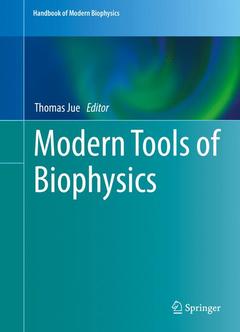Description
Modern Tools of Biophysics, Softcover reprint of the original 1st ed. 2017
Handbook of Modern Biophysics Series, Vol. 5
Language: English
Subject for Modern Tools of Biophysics:
Keywords
Rosetta; diffraction; lanthanides; microscopy; non-linear optics
Modern Tools of Biophysics
Publication date: 05-2017
Support: Print on demand
Publication date: 05-2017
Support: Print on demand
Modern Tools of Biophysics
Publication date: 07-2018
Support: Print on demand
Publication date: 07-2018
Support: Print on demand
Description
/li>Contents
/li>Biography
/li>Comment
/li>
Handbook of Modern Biophysics brings current biophysics topics into focus, so that biology, medical, engineering, mathematics, and physical-science students or researchers can learn fun¬damental concepts and the application of new techniques in addressing biomedical challenges. Chapters will develop the conceptual framework of the physics formalism and illustrate the biomedical applica¬tions. With the addition of problem sets, guides to further study, and references, the interested reader can continue to independently explore the ideas presented.
Volume 5: Modern Tools of Biophysics
Editor: Thomas Jue, PhD
In Modern Tools of Biophysics, a group of prominent professors have provided insights into the tools used in biophysics with respect to the following topics:
- Wave Theory of Image Formation in a Microscope: Basic Theory and Experiments
- Computer Simulations and Nonlinear Dynamics of Cardiac Action Potentials
- Myoglobin and Hemoglobin Contribution to the NIRS Signal in Muscle
- Anomalous Low Angle X-Ray Scattering of Membrane with Lanthanides
- Recording of Ionic Currents under Physiological Conditions?Action Potential-Clamping and ?Onion-Peeling? Techniques
- Patch Clamp Technique and Applications
About the Editor
Thomas Jue is a Professor in the Department of Biochemistry and Molecular Medicine at the University of California, Davis. He is an internationally recognized expert in developing and applying magnetic resonance techniques to study animal as well as human physiology in vivo and has published extensively in the field of magnetic resonance spectroscopy and imaging, near-infrared spectroscopy, bioenergetics, cardiovascular regulation, exercise, and marine biology. He served as a Chair of the Biophysics Graduate Group Program at UC Davis, where he started to develop scholarly approaches to educate graduate students with a balance of physical-science/mathematics formalism and biomedical perspective in order to promote interest at the interface of physical science, engineering, mathematics, biology, and medicine. He continues to develop the biophysics curriculum, and the Handbook of Modern Biophysics represents an aspect of that effort.
Wave Theory of Image Formation in a Microscope.- Recording of ionic currents under physiological conditions: Action Potential-Clamp and "Onion-Peeling" techniques.- Patch Clamp Technique and Applications.- Structural Insights from Membrane Small Angle X-ray Diffraction with Anomalous X-ray Scattering.- Computer simulations and nonlinear dynamics of cardiac action potentials.- Hemoglobin and myoglobin contribution to the NIRS signal in skeletal muscle.
Thomas Jue is a Professor in the Department of Biochemistry and Molecular Medicine at the University of California, Davis. He is an internationally recognized expert in developing and applying magnetic resonance techniques to study animal as well as human physiology in vivo and has published extensively in the field of magnetic resonance spectroscopy and imaging, near-infrared spectroscopy, bioenergetics, cardiovascular regulation, exercise, and marine biology. He served as a Chair of the Biophysics Graduate Group Program at UC Davis, where he started to develop scholarly approaches to educate graduate students with a balance of physical-science/mathematics formalism and biomedical perspective in order to promote interest at the interface of physical science, engineering, mathematics, biology, and medicine. He continues to develop the biophysics curriculum, and the Handbook of Modern Biophysics represents an aspect of that effort.
Written by leaders in the biophysics field All topics are covered by concept and then biological application Each chapter will contain didactic elements that facilitate teaching, self-study, and research preparation Includes supplementary material: sn.pub/extras
© 2024 LAVOISIER S.A.S.

